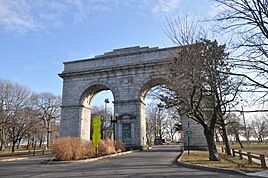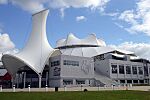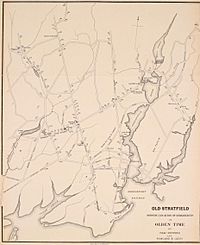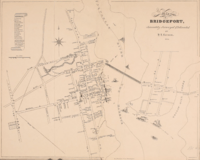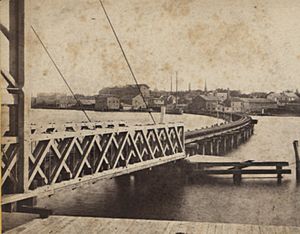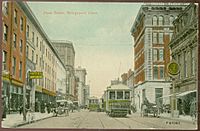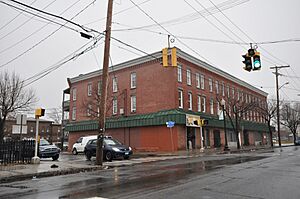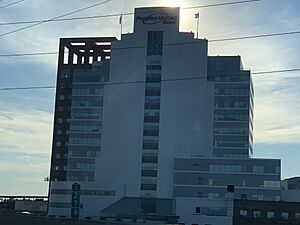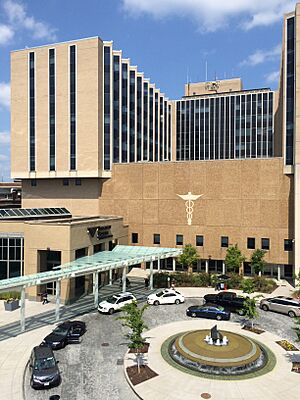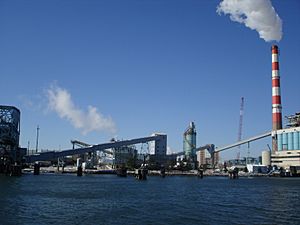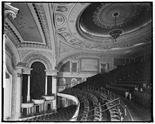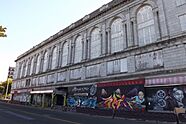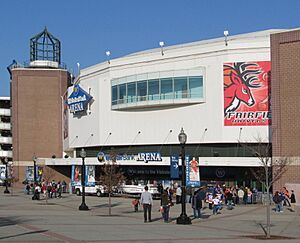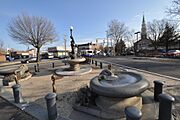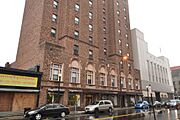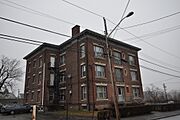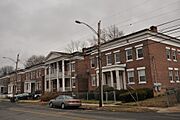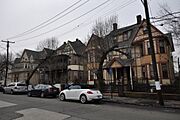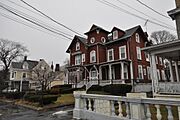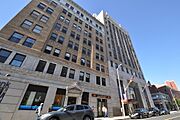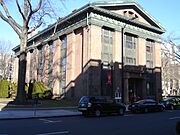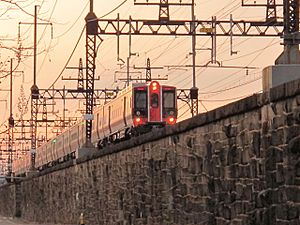Bridgeport, Connecticut facts for kids
Quick facts for kids
Bridgeport
|
|||||
|---|---|---|---|---|---|
|
Perry Memorial Arch, facing southwards towards Seaside Park
Downtown Bridgeport
Total Mortgage Arena
Bridgeport Station
Hartford HealthCare Amphitheater
Bridgeport Center
Connecticut's Beardsley Zoo
|
|||||
|
|||||
| Nicknames:
The Park City, BPT
|
|||||
Motto(s):
|
|||||
 Fairfield County and Connecticut Fairfield County and Connecticut |
|||||
| Country | United States | ||||
| State | Connecticut | ||||
| County | Fairfield | ||||
| Region | CT Metropolitan | ||||
| MSA | Bridgeport-Stamford-Norwalk | ||||
| CSA | New York | ||||
| Incorporated (town) | 1821 | ||||
| Incorporated (city) | 1836 | ||||
| Named for | A drawbridge over the Pequonnock River | ||||
| Government | |||||
| • Type | Mayor-council | ||||
| Area | |||||
| • City | 19.4 sq mi (50.2 km2) | ||||
| • Land | 16.0 sq mi (41.4 km2) | ||||
| • Water | 3.4 sq mi (8.8 km2) | ||||
| • Urban | 397.29 sq mi (1,029.0 km2) | ||||
| Elevation | 3 ft (1 m) | ||||
| Population
(2020)
|
|||||
| • City | 148,654 | ||||
| • Rank | US: 172nd | ||||
| • Density | 9,290.875/sq mi (3,587.228/km2) | ||||
| • Urban | 916,408 (US: 51st) | ||||
| • Urban density | 2,306.6/sq mi (890.6/km2) | ||||
| • Metro | 939,904 (US: 57th) | ||||
| Demonym(s) | Bridgeporter | ||||
| GDP | |||||
| • Bridgeport (MSA) | 4.368 billion (2022) | ||||
| Time zone | UTC−5 (Eastern) | ||||
| • Summer (DST) | UTC−4 (Eastern) | ||||
| ZIP Codes |
06601–06602, 06604–06608, 06610, 06650, 06673, 06699
|
||||
| Area code(s) | 203/475 | ||||
| FIPS code | 09-08000 | ||||
| GNIS feature ID | 205720 | ||||
| Airport | Sikorsky Memorial Airport | ||||
| Major highways | |||||
| Commuter rail | |||||
Bridgeport is the most populous city in the U.S. state of Connecticut and the fifth-most populous city in New England, with a population of 148,654 in 2020. Located in eastern Fairfield County at the mouth of the Pequonnock River on Long Island Sound, it is a port city 60 miles (97 km) from Manhattan and 40 miles (64 km) from The Bronx. It borders the towns of Trumbull to the north, Fairfield to the west, and Stratford to the east. Bridgeport and other towns in Fairfield County make up the Greater Bridgeport Planning Region, as well as the Bridgeport–Stamford–Norwalk–Danbury metropolitan statistical area, the second largest metropolitan area in Connecticut. The Bridgeport–Stamford–Norwalk–Danbury metropolis forms part of the New York metropolitan area.
Inhabited by the Paugussett Native American tribe until English settlement in the 1600s, Bridgeport was incorporated in 1821 as a town, and as a city in 1836. Showman P. T. Barnum was a resident of the city and served as the town's mayor (1871). Barnum built four houses in Bridgeport and housed his circus in town during winter. The city in the early 20th century saw an economic and population boom, becoming by all measures Connecticut's chief manufacturing city by 1905. Bridgeport was the site of the world's first mutual telephone exchange (1877), the first dental hygiene school (1949), and the first bank telephone bill service in the US (1981). Inventor Harvey Hubbell II invented the electric plug outlet in Bridgeport in 1912. The Frisbie Pie Company was founded and operated in Bridgeport. The world's first Subway restaurant opened in the city's North End in 1965. After World War II, industrial restructuring and suburbanization caused the loss of many large companies and affluent residents, leaving Bridgeport struggling with issues of poverty and violent crime.
Since the beginning of the 21st century, Bridgeport has begun extensive redevelopment of its downtown and other neighborhoods. Bridgeport's crime rate started going down significantly around 2010; by 2018, it had been reduced by almost 50 percent. Bridgeport is home to three museums, the University of Bridgeport, Housatonic Community College, Paier College, and part of Sacred Heart University as well as the state's only zoo. Bridgeport is officially nicknamed "Park City", due to its 35 public parks taking up 1,300 acres, including two large ones. Although none are headquartered within the city itself, more than a dozen Fortune 500 companies are based in its metropolitan area, which it shares with Stamford. Bridgeport by various sites has been consistently ranked as among the 25 most ethnically and culturally diverse American cities.
Contents
History
Colonial history
The first documented English settlement within the present city limits of Bridgeport took place in 1644, centered at Black Rock Harbor along North Avenue and between Park and Briarwood Avenues. The place was called Pequonnock (Quiripi for "Cleared Land"), after a band of the Paugussett, a Native American people who then occupied this area. One of their sacred sites was Golden Hill, which overlooked the harbor and was the location of natural springs and their planting fields. (It has since been blasted through for an expressway.) The Golden Hill Indians were granted a reservation here by the Colony of Connecticut in 1639 that survived until 1802. (It exists today in adjoining Trumbull.)
Bridgeport's early years were marked by residents' reliance on fishing and farming, not altogether different from the economy of the Native Americans, who had cultivated corn, beans, and squash and fished and gathered shellfish from both the river and sound. A village called Newfield began to coalesce around the corner of State and Water Streets in the 1760s. The area officially became known as Stratfield in 1695 or 1701 due to its location between the already existing towns of Stratford and Fairfield. During the American Revolution, Newfield Harbor was a center of privateering.
19th century
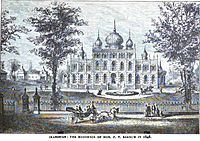
By the time of the State of Connecticut's ratification of the American constitution in 1781, many of the local farmers held shares in vessels trading at Newfield Harbor or had begun trading in their own name. Newfield initially expanded around the coasting trade with Boston, New York, and Baltimore and the international trade with the West Indies. The commercial activity of the village was clustered around the wharves on the west bank of the Pequonnock, while the churches were erected inland on Broad Street. In 1800, the village became the Borough of Bridgeport, the first so incorporated in the state. It was named for the Newfield or Lottery Bridge across the Pequonnock, connecting the wharves on its east and west banks. Bridgeport Bank was established in 1806. In 1821, the township of Bridgeport became independent of Stratford.
The West India trade died down around 1840, but by that time the Bridgeport Steamship Company (1824) and Bridgeport Whaling Company (1833) had been incorporated and the Housatonic Railroad chartered (1836). The same year, the New York and New Haven Railroad began operation, connecting Bridgeport to New York and the other towns along the north shore of the Long Island Sound.
Now a major junction for western Connecticut, the city rapidly industrialized. Following the Civil War, it held several iron foundries and factories manufacturing firearms, metallic cartridges, horse harnesses, locks, and blinds. Wheeler & Wilson's sewing machines were exported throughout the world. Bridgeport annexed the West End and the village of Black Rock and its busy harbor in 1870. In 1875, P.T. Barnum was elected mayor of the town, which afterwards served as the winter headquarters of Barnum and Bailey's Circus and Buffalo Bill's Wild West Show.
20th century
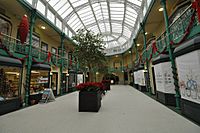
From 1870 to 1910, Bridgeport became the major industrial center of Connecticut and its population rose from around 25,000 to over 100,000, including thousands of Irish, Slovaks, Hungarians, Germans, English, and Italian immigrants. A Singer factory joined Wheeler & Wilson in producing sewing machines and the Locomobile Company of America was a prominent early automobile manufacturer, producing a prototype of the Stanley Steamer and various luxury cars. The town was the center of America's corset production, responsible for almost 20% of the national total, and became the headquarters of Remington Arms following its 1912 merger with the Union Metallic Cartridge Co. Around the time of the First World War, Bridgeport was also producing steam-fitting and heating apparatuses, brass goods, phonographs, typewriters, milling machines, brassieres, and saddles.
A series of strikes in the summer of 1915 imposed the eight-hour day on the town's factories; rather than moving business elsewhere, the success spread the eight-hour day throughout the Northeast. The First World War continued the city's expansion so that, on the eve of the Great Depression, there were more than 500 factories in Bridgeport, including Columbia Records' primary pressing plant. The build-up to World War II helped its recovery in the late 1930s.
Restructuring of heavy industry starting after the mid-20th century caused the loss of thousands of jobs and residents. Like other urban centers in Connecticut, Bridgeport suffered during the deindustrialization of the United States in the 1970s and 1980s. Continued development of new suburban housing attracted middle and upper-class residents, leaving the city with a higher proportion of poor. The city suffered from overall mismanagement, for which several city officials were convicted, contributing to the economic and social decline. In September 1978, Bridgeport teachers went on a 19-day strike due to deadlocked contract negotiations. A court order, as well as a state law that made strikes by public workers illegal in Connecticut, resulted in 274 teachers being arrested and jailed. Bridgeport made numerous efforts at revitalization. In one proposal, Las Vegas developer Steve Wynn was to build a large casino, but that project failed. In 1991, the city filed for bankruptcy protection but was declared solvent by a federal court.
21st century
In the early 21st century, Bridgeport has taken steps toward redevelopment of its downtown and other neighborhoods. In 2004, artists' lofts were developed in the former Read's Department Store on Broad Street. Several other rental conversions have been completed, including the 117-unit Citytrust bank building on Main Street. The recession halted, at least temporarily, two major mixed-use projects including a $1-billion waterfront development at Steel Point, but other redevelopment projects have proceeded, such as the condominium conversion project in Bijou Square. In 2009, the City Council approved a new master plan for development, designed both to promote redevelopment in selected areas and to protect existing residential neighborhoods. In 2010, the Bridgeport Housing Authority and a local health center announced plans to build a $20 million medical and housing complex at Albion Street, making use of federal stimulus funds and designed to replace some of the housing lost with the demolition of Father Panik Village.
Notable speeches
On March 10, 1860, Abraham Lincoln spoke in the city's Washington Hall, an auditorium at the old Bridgeport City Hall (now McLevy Hall), at the corner of State and Broad Streets. The largest room in the city was packed, and a crowd formed outside, as well. Lincoln received a standing ovation before taking the 9:07 pm train that night back to Manhattan. A plaque marks the site where Lincoln spoke; later that year, he was elected president.
The Rev. Martin Luther King, Jr. spoke three times at the Klein Auditorium during the 1960s. Additionally, President George W. Bush spoke before a small group of Connecticut business people and officials at the Playhouse on the Green in 2006. President Barack Obama also spoke at the Harbor Yard arena in 2010 to gain support for the campaign of Democratic Governor Dan Malloy.
Geography
Bridgeport is located along Long Island Sound at the mouth of the Pequonnock River, named for the Native American tribe who historically lived along it.
Parks
Bridgeport is renowned for its public park system, which has led to its official nickname as "The Park City". The city's first public park was the westerly portion of McLevy Green, first set aside as a public square 1806, although the Clinton Park Militia Grounds (1666) and Old Mill Green (1717) were set aside earlier as public commons by the towns of Fairfield and Stratford, respectively. As the city rapidly grew in population, residents recognized the need for more public parks and by 1864, Barnum and other residents had donated approximately 44 acres (180,000 m2) to create Seaside Park, now increased by acquisition and landfill to 375 acres (1.52 km2). In 1878, over 100 acres (400,000 m2) of land bordering the Pequonnock River was added as Beardsley Park. Frederick Law Olmsted, famous for creating New York City's Central Park, designed both Seaside and Beardsley Parks. Over time, more parks were added including 35-acre (140,000 m2) Beechwood Park and Pleasure Beach, home to a popular amusement park for many years.
Neighborhoods
The city of Bridgeport is divided into many distinct neighborhoods, divided into five geographic areas: Downtown, the East Side, the North End, the South End, and the West Side.
- Downtown
- McLeevy Green
- Harral Square
- The Hollow
- Enterprise Zone
- East Side
- Boston Avenue/Mill Hill
- East End
- Lower East Side
- Newfield
- Pleasure Beach
- Steel Point
- Upper East Side
- North End
- Brooklawn/St. Vincent
- Lake Forest
- Lake Success
- North Bridgeport/Little Italy
- Reservoir/Whiskey Hill
- South End
- Seaside Park
- Soundgate
- West Side
- Black Rock
- West End
Climate
Under the Köppen climate classification, Bridgeport straddles between a humid subtropical (Cfa) and humid continental (Dfa) climate, with some maritime influence; it is part of USDA hardiness zone 7a. The normal average monthly temperature ranges from 30.1 °F (−1.1 °C) in January to 74.3 °F (23.5 °C) in July; on average, there are 20 days where the temperature remains at or below freezing and 7.6 days with a high at or above 90 °F (32 °C) annually; the last year to not reach the latter mark was 2004. Temperatures reaching 0 °F (−18 °C) or 100 °F (38 °C) are rare, and were last seen respectively on February 14, 2016 and July 22, 2011. The record low is −7 °F (−22 °C), set on January 22, 1984, while the record high is 103 °F (39 °C), set on July 22 in 1957 and 2011.
Precipitation averages 42.7 inches (1,080 mm) annually, and is somewhat evenly distributed throughout the year, though March and April are the wettest months in terms of total precipitation. Snowfall averages 27.6 inches (70 cm) per winter, falling almost entirely from December to March. As is typical of coastal Connecticut, snow cover does not usually remain for long, with an average of 29 days per winter with snow cover of at least 1 inch (2.5 cm).
| Climate data for Bridgeport, Connecticut (Sikorsky Airport), 1981–2010 normals, extremes 1948–present | |||||||||||||
|---|---|---|---|---|---|---|---|---|---|---|---|---|---|
| Month | Jan | Feb | Mar | Apr | May | Jun | Jul | Aug | Sep | Oct | Nov | Dec | Year |
| Record high °F (°C) | 68 (20) |
67 (19) |
84 (29) |
91 (33) |
97 (36) |
97 (36) |
103 (39) |
100 (38) |
99 (37) |
89 (32) |
78 (26) |
76 (24) |
103 (39) |
| Mean maximum °F (°C) | 55.2 (12.9) |
55.4 (13.0) |
65.8 (18.8) |
76.4 (24.7) |
83.7 (28.7) |
89.9 (32.2) |
92.9 (33.8) |
91.4 (33.0) |
85.1 (29.5) |
76.6 (24.8) |
67.4 (19.7) |
58.6 (14.8) |
94.6 (34.8) |
| Mean daily maximum °F (°C) | 37.1 (2.8) |
39.7 (4.3) |
47.2 (8.4) |
57.7 (14.3) |
67.6 (19.8) |
77.0 (25.0) |
82.2 (27.9) |
80.9 (27.2) |
74.0 (23.3) |
63.3 (17.4) |
53.1 (11.7) |
42.3 (5.7) |
60.2 (15.7) |
| Mean daily minimum °F (°C) | 23.0 (−5.0) |
25.2 (−3.8) |
31.4 (−0.3) |
41.0 (5.0) |
50.6 (10.3) |
60.4 (15.8) |
66.4 (19.1) |
65.8 (18.8) |
58.3 (14.6) |
46.5 (8.1) |
38.0 (3.3) |
28.4 (−2.0) |
44.6 (7.0) |
| Mean minimum °F (°C) | 5.3 (−14.8) |
9.8 (−12.3) |
16.3 (−8.7) |
30.0 (−1.1) |
39.7 (4.3) |
49.5 (9.7) |
57.0 (13.9) |
54.9 (12.7) |
44.6 (7.0) |
33.4 (0.8) |
23.8 (−4.6) |
12.9 (−10.6) |
3.5 (−15.8) |
| Record low °F (°C) | −7 (−22) |
−6 (−21) |
4 (−16) |
18 (−8) |
31 (−1) |
41 (5) |
49 (9) |
44 (7) |
36 (2) |
26 (−3) |
16 (−9) |
−4 (−20) |
−7 (−22) |
| Average precipitation inches (mm) | 3.10 (79) |
2.79 (71) |
4.05 (103) |
4.13 (105) |
3.80 (97) |
3.61 (92) |
3.46 (88) |
3.96 (101) |
3.48 (88) |
3.64 (92) |
3.39 (86) |
3.33 (85) |
42.74 (1,087) |
| Average snowfall inches (cm) | 7.7 (20) |
8.1 (21) |
5.1 (13) |
0.9 (2.3) |
0 (0) |
0 (0) |
0 (0) |
0 (0) |
0 (0) |
0 (0) |
0.7 (1.8) |
5.1 (13) |
27.6 (71.1) |
| Average precipitation days (≥ 0.01 inch) | 10.9 | 9.7 | 11.3 | 11.0 | 11.8 | 11.1 | 8.9 | 8.9 | 8.2 | 8.8 | 10.0 | 11.1 | 121.7 |
| Average snowy days (≥ 0.1 inch) | 4.8 | 3.5 | 2.4 | 0.3 | 0 | 0 | 0 | 0 | 0 | 0 | 0.5 | 3.1 | 14.6 |
| Source: NOAA | |||||||||||||
Demographics
| Historical population | |||
|---|---|---|---|
| Census | Pop. | %± | |
| 1810 | 1,089 | — | |
| 1820 | 1,500 | 37.7% | |
| 1830 | 2,800 | 86.7% | |
| 1840 | 3,294 | 17.6% | |
| 1850 | 7,560 | 129.5% | |
| 1860 | 13,299 | 75.9% | |
| 1870 | 18,969 | 42.6% | |
| 1880 | 27,643 | 45.7% | |
| 1890 | 48,866 | 76.8% | |
| 1900 | 70,996 | 45.3% | |
| 1910 | 102,054 | 43.7% | |
| 1920 | 143,555 | 40.7% | |
| 1930 | 146,716 | 2.2% | |
| 1940 | 147,121 | 0.3% | |
| 1950 | 158,709 | 7.9% | |
| 1960 | 156,748 | −1.2% | |
| 1970 | 156,542 | −0.1% | |
| 1980 | 142,546 | −8.9% | |
| 1990 | 141,686 | −0.6% | |
| 2000 | 139,529 | −1.5% | |
| 2010 | 144,229 | 3.4% | |
| 2020 | 148,654 | 3.1% | |
| Population 1840–1970 U.S. Decennial Census 2018 Estimate |
|||
2020 census
| Race / Ethnicity (NH = Non-Hispanic) | Pop 2000 | Pop 2010 | Pop 2020 | % 2000 | % 2010 | % 2020 |
|---|---|---|---|---|---|---|
| White alone (NH) | 43,158 | 32,794 | 24,404 | 30.93% | 22.74% | 16.42% |
| Black or African American alone (NH) | 40,974 | 46,472 | 48,690 | 29.37% | 32.22% | 32.75% |
| Native American or Alaska Native alone (NH) | 352 | 286 | 228 | 0.25% | 0.20% | 0.15% |
| Asian alone (NH) | 4,459 | 4,781 | 4,024 | 3.20% | 3.31% | 2.71% |
| Pacific Islander alone (NH) | 102 | 66 | 31 | 0.07% | 0.05% | 0.02% |
| Some Other Race alone (NH) | 1,218 | 1,930 | 2,938 | 0.87% | 1.34% | 1.98% |
| Mixed Race or Multi-Racial (NH) | 4,788 | 2,800 | 5,486 | 3.43% | 1.94% | 3.69% |
| Hispanic or Latino (any race) | 44,478 | 55,100 | 62,853 | 31.88% | 38.20% | 42.28% |
| Total | 139,529 | 144,229 | 148,654 | 100.00% | 100.00% | 100.00% |
2010 census
As of the 2010 census, there were 144,229 people living in the city. The racial makeup of the city residents was 39.6% White; 34.6% Black or African American; 3.4% Asian; and 4.3% from two or more races. A total of 38.2% of the population were Hispanic or Latino of any race.
There were 50,307 households, out of which 34.3% had children under the age of 18 living with them, 35.0% were married couples living together, 24.0% had a female householder with no husband present, and 34.9% were non-families. 29.0% of all households were made up of individuals, and 11.3% had someone living alone who was 65 years of age or older. The average household size was 2.70 and the average family size was 3.34.
In the city, the population was spread out, with 28.4% under the age of 18, 11.2% from 18 to 24, 30.5% from 25 to 44, 18.4% from 45 to 64, and 11.5% who were 65 years of age or older. The median age was 31 years. For every 100 females, there were 91.2 males. For every 100 females age 18 and over, there were 86.3 males.
The median income for a household in the city was $34,658, and the median income for a family was $39,571. Males had a median income of $32,430 versus $26,966 for females. The per capita income for the city was $16,306. About 16.2% of families and 18.4% of the population were below the poverty line, including 24.8% of those under age 18 and 13.2% of those age 65 or over.
According to the 2020 five-year community survey, 48.2% of Bridgeport's population speaks a different primary language at home other than English, 33.8% percent of the city's total population speaks Spanish at home, and 22.5% speak English less than very well. Bridgeport has the largest percentage and population of Hispanic Americans in the state of Connecticut. The city is known for having one of the largest communities of Puerto Ricans in the United States; Bridgeport has the 7th largest Puerto Rican population in the United States, with 30,250 people claiming Puerto Rican heritage in 1990, that number has grown to about 31,900 (22.10% of the population) in 2013. 45,270 people (31%) of Bridgeport's population is foreign born in 2010. Other than Puerto Ricans, 5.4% of Bridgeport's population was noted under Mexican in 2013, a number that has grown to 5.8% (8,479 people) in the 2020 five-year American Community Survey, meaning Bridgeport has the largest Mexican population in New England.Dominicans are 5,248 (3.53%) of Bridgeport's population. The total Latino Central American population (Guatemalans, Salvadorians, Nicaraguans, Hondurans, Costa Ricans, Panamanians) is 6,701 people total in the city (4.507%). 8,454 South Americans (5.697%); 4,020 Equadorians, 2,326 Colombians, Peruvians, and then populations from every Latin American nation except Bolivia can be found, with the smallest group being Paraguayans at 16 people according to the census. Bridgeport also has the largest Cuban population in the state, with more than 1,000 of the state's 10,600 Cubans living in Bridgeport, although down from the at least 5,000 Cubans in Bridgeport in 1980, and even more before that time in the 1950s according to the CTPost. Bridgeport was once a major destination for migrating Cubans, but many families have since moved to the city's suburbs or Florida. Bridgeport, along with Danbury, CT were considered as a potential locations for a new Ecuadorian consulate, but it instead opened in New Haven, CT, due to its immigrant welcoming mayor, in 2008.
As for Portuguese-speaking peoples, the city also has the 12th largest Cape Verdean population in the country. The group settled in the Hollow to work in factories and established a social club in the 1940s. The Cape Verdean Association of Bridgeport is located in the Hollow today. The Portuguese community in the city is the largest in the state and the population primarily hails from the Tras Os Montes region of Portugal according to a 2018 research study, and the Hollow is considered the "Portuguese section" of Bridgeport. The large Brazilian population in Bridgeport and Danbury led to the opening of a Brazilian consulate in the state capital of Hartford. Migration to Connecticut began in the 90s, social networks brought immigrants from Governador Valadares, Minas Gerais in Brazil to Bridgeport, CT and Framingham, MA. Fairfield County has the 7th largest Brazilian population of the United States, and 1/3rd of them live within Bridgeport's city limits, most of whom reside in the city's North End and St. Vincent neighborhood.
A small population of people from various majority-Muslim nations exists along with Kurds, at least 4,000 according to an estimate by a local mosque in 2008. Bridgeport Public Schools now observes Eid al-Fitr, effective 2024, thanks to a campaign by city 8th graders from Park City Magnet School, which found 10% of the school body was Muslim in a school project. Bengali in 2022 was the fifth most common primary language for Bridgeport Public School students (behind English, Spanish, Portuguese, and Haitian Creole, and is followed by Arabic at sixth place). There is also a sizeable Kurdish population in Bridgeport, primarily from Iraq. In total (and counting East and Southeast Asians), Bridgeport had 7,725 Asian residents according to the 2021 5 year American Community Survey, up from 2020's count, 5,553 Asians. The largest national origin groups and their estimated populations are Vietnamese (1,258 people), Indian (1,153 people), Chinese, excluding Taiwanese and Pakistanis (both 982 people), and Filipinos (729 people). Other groups with over 500 people include Laotians and Cambodians, Bangladeshi Americans in the city numbered 385 people in the survey.
Jamaicans, the state's largest foreign-born group, have a significant presence in Bridgeport, with 6.3% of Bridgeport's population being Jamaican in 2013. Bridgeport in 2013 was 10.2% non-Hispanic West Indian.
At least 92 languages are spoken as primary languages by Bridgeport Public School students according to district data in 2022. 3,145 students are missing data in primary language.
The Bridgeport-Stamford metropolitan area (i.e.: Fairfield County) is home to the 7th largest percentage of Italian ancestry in the country (the population is 16.5% Italian). Italian Americans until 1985 were the largest ethnic group in Bridgeport itself, and had been since the 1920s. According to 2010 census data, the Bridgeport MSA, containing all of Fairfield County, is the most economically unequal region in America, with 57% of the wealth going to the top income quintile.
As of the census of 2000, there were 139,529 people, 50,307 households, and 32,749 families living in the city. The population density was 8,720.9 inhabitants per square mile (3,367.2/km2). There were 54,367 housing units at an average density of 3,398.1 per square mile (1,312.0/km2). The racial makeup of the city was 45.0% White, 30.8% African American, 0.5% Native American, 3.3% Asian, 0.1% Pacific Islander. Hispanic or Latino people of any race were 31.9% of the population. European (white) ancestry groups include: Italian (8.6%), Irish (5.1%), Portuguese (2.9%), Polish (2.8%), and German (2.4%).
Economy
Since the decline of its industrial sector beginning in the middle of the 20th century, Bridgeport has gradually adjusted to a service-based economy. As late as 1985, the city was still home to company plants such as General Electric, with 1,900 employees, and Remington Products, with 900, both of which are now closed. Bryant Electric didn't close its plant until 1988. The last major factory to close was the Sikorsky helicopter plant in 2015. Various famous industrial companies, that were founded and based in Bridgeport, such as ACME Sheer, Fortune 1000 Hubbell Incorporated, etc. are now based in suburban Shelton, two towns away. Subway, which started out in Bridgeport in 1965, is now based in Milford.
Though a level of industrial activity continues, healthcare, finance, and education have become the centerpieces of Bridgeport's economy.
The two largest employers in the city are Bridgeport's primary hospitals, Bridgeport Hospital and St. Vincent's Medical Center. Park City Hospital in the South End closed in 1993 and was reopened in 2010 as elderly and homeless housing units.
In April 2022, M&T Bank of Buffalo, New York, merged with Bridgeport-based People's United Financial. The combined company is now the 11th largest bank in the United States, and gave M&T a foothold in the New England market, in total serving 12 states. Although M&T laid off Bridgeport employees (which made national headlines), the company as part of this effort made Bridgeport Center the regional M&T headquarters of New England.
Top employers
Top employers in Bridgeport according to the city's 2020 Comprehensive Annual Financial Report:
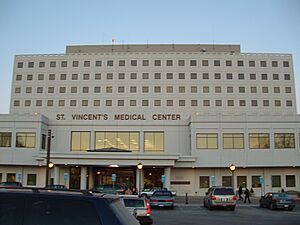
| # | Employer | # of employees |
|---|---|---|
| 1 | Bridgeport Hospital | 3,243 |
| 2 | St. Vincent's Medical Center | 1,800 |
| 3 | M&T Bank | 1,117 |
| 4 | Jewish Senior Services Center | 358 |
| 5 | Goodwin University | 526 |
| 6 | Sikorsky Aircraft | 383 |
| 7 | Housatonic Community College | 343 |
| 8 | Lacey Manufacturing Co. | 350 |
| 9 | Bridgeport Healthcare Center | 297 |
| 10 | alphabroder Prime Line | 253 |
Arts and culture
Performing arts
Theater and music
Venues for live theater and music events include:
- Downtown Cabaret Theatre – cabaret, children's theater, concerts
- The Stress Factory (300 seats) – comedy club with national and local acts
- Klein Memorial Auditorium (1,400 seats) – home to the Greater Bridgeport Symphony, touring shows and concerts
- Total Mortgage Arena – sporting events venue, but also hosts large concerts
- Hartford HealthCare Amphitheater - outdoor concert venue
Music festivals and concert series
Bridgeport was the annual home to Gathering of the Vibes, a weekend-long arts, music and camping festival, until it ended in 2015.
Beginning in 2022, Bridgeport played host to the Sound on Sound Music Festival, at Seaside Park. Past performers included; John Mayer, Red Hot Chili Peppers, Dave Matthews Band, Hozier, and The Roots. The festival was rebranded in 2024 to Soundside Music Festival.
The Greater Bridgeport Symphony, established in 1945, performs at Bridgeport's 1,400-seat Klein Memorial Auditorium. Gustav Meier directed the orchestra from 1972 to 2013.
Museums and zoos
- The Discovery Science Center and Planetarium emphasizes exhibits on science, with the state's only Challenger Center, affiliated with the national space program. Opened in 1962 and run by SHU as of 2020.
- The Housatonic Museum of Art at Housatonic Community College has the largest collection of art of any two-year college in the nation. Founded in 1967 by collage art director Bob Chernow. Shows both western and non-western art from different eras, including sculptures.
- The Barnum Museum celebrates the showman, circuses and Bridgeport history. Currently under renovation, a room is open to visitors every Thursday.
- The Beardsley Zoo, opened 1922, is the only such center in Connecticut, and is the state's largest zoo.
The Greater Bridgeport metropolitan area is home to the Maritime Aquarium in Norwalk, 30 minutes from downtown Bridgeport. One of the two aquariums in Connecticut, the aquarium focuses on Long Island Sound as well as creatures and conservation efforts from around the world.
Historic districts
Bridgeport has five local historic districts, where exterior changes to structures are under the control of two Historic District Commissions:
- Black Rock Harbor Historic District
- Pembroke City Historic District
- Stratfield Historic District
- Barnum-Palliser Development Historic District
- Marina Park Historic District
- Downtown North Historic District
- Downtown South Historic District
- Remington City Historic District
- Black Rock Gardens Historic District
- Seaside Village Historic District
- AMFAB Art Building
Bridgeport was once home to a Little Asia along Wood Avenue in the West Side, established in 2012 by local business owners with a sign and a festival every year. By 2016 the name had fallen out of use, and the committee no longer exists. The more or less 3 or 4 block area is still home to Asian restaurants, an insurance and tax agency with Vietnamese, Mandarin, Laotian, Cantonese as well as Spanish language services, and a Vietnamese grocery store.
Cuisine
NerdWallet ranked Bridgeport the 100th most foodie city in the United States, 2nd in Connecticut behind New Haven (which was ranked #97). Nerdwallet in 2022 ranked Bridgeport as the 17th most ethnically diverse city in the United States, making it the most diverse in New England, and the third most diverse in the New York Metropolitan Area in an annual ranking. It ranked 23rd in 2021, and #22 in 2015. It is #28 on Niche.com "2022 Most Diverse Cities in America" list. Bridgeport's Madison Avenue, and Hollow Brazilian restaurants, located alongside various Portuguese ones, have been mentioned by publications such as the New York Times. Examples include churascaria restaurants. It is "among the top cities in the state to immerse yourself in Brazilian traditions" according to CTBites. Azteca was ranked among the best Mexican restaurants in Connecticut in 2020 according to Connecticut Magazine, along with Pho Hong Thom and Pho Saigon in Bridgeport's Little Asia on the West Side for best Vietnamese places in the state.
Sports
| Club | League | Venue | Established | Championships |
|---|---|---|---|---|
| Bridgeport Islanders | AHL | Total Mortgage Arena | 2001 | 0 |
| CT United FC | MLS Next Pro | New Waterfront Stadium | 2024 | 0 |
Total Mortgage Arena serves as the city's sports and hospitality center. Seating 10,000, the Arena serves as the home rink of the Bridgeport Islanders American Hockey League team, the farm team of the New York Islanders of the National Hockey League. Starting in 2024, it also serves as the home of the New York Sirens of the Professional Women's Hockey League.
The arena served as the temporary home of the Westchester Knicks of the NBA G League (the farm team for the NBA New York Knicks) from 2021 to 2023 when the team's home stadium, Westchester County Center in White Plains, NY iwas being used as a vaccination clinic.
For college teams, Total Mortgage serves as the home court of Fairfield University's basketball team.
The Ballpark at Harbor Yard served as a minor-league baseball stadium from 1998 to 2017. It was built in 1998 to serve as the homefield of the Bridgeport Bluefish. From 2001 to 2003 it was the homefield for the Bridgeport Barrage, a Major League Lacrosse team. It is downtown on a former brownfield site. It is visually prominent to commuters on I-95 or on passing trains. On August 8, 2017, Mayor Joe Ganim announced that the Bluefish would be ending their 20-year stint at the ballpark at the end of the 2017 season. The ballpark was converted into an amphitheatre. The Bluefish played their final home game at the park on September 17, 2017, losing by a score of 9–2 to the Somerset Patriots.
Kennedy Stadium serves as a community sports facility. In the late 1960s and early 1970s, it was the home of an Atlantic Coast Football League minor league football team, the Bridgeport Jets, a New York Jets farm team also known locally as the Hi-Ho Jets due to their sponsorship by the (Hi-Ho) D'Addario construction company.
Fairfield University is in the neighboring town of Fairfield, and many of the athletic teams play on campus. Only the men's and women's basketball teams play in Bridgeport.
Nutmeg Curling Club, one of two curling clubs in Connecticut, is in Bridgeport. It is the home club of the 2013 USA Mixed National Champions, led by club members Derek Surka and Charissa Lin. The club is a member of the Grand National Curling Club Region.
Bridgeport native Jim O'Rourke was the first baseball player to earn a hit in National League history in 1876. The founder and original owner of the Brooklyn Dodgers, Charles Ebbets, married his second wife in Bridgeport in 1922, five years before his death.
In early 2024, MLS Next Pro awarded an expansion team to Bridgeport. Connecticut United FC plan to play at a new stadium to be located on the waterfront at a former dog-racing track, as stadium plans were approved by the Bridgeport government in November 2023.
Amateur soccer team GZS Bridgeport play in the UPSL, playing home games at Kennedy Stadium.
Parks and recreation
- Photos from Bridgeport's public parks
The city has 1,300 acres of public space, with a pocket park in nearly every neighborhood. Bridgeport's public park system led to its official nickname, "the Park City". The city's first public park was the westerly portion of McLevy Green, first set aside as a public square in 1806; the Clinton Park Militia Grounds (1666) and Old Mill Green (1717) were set aside earlier as public commons by the towns of Fairfield and Stratford, respectively. Washington Park in 1850 was located in the center of East Bridgeport. As the city rapidly grew in population, residents recognized the need for more public parks and by 1864, Barnum and other residents had donated approximately 44 acres (18 ha) to create Seaside Park, now increased by acquisition and landfill to 375 acres (152 ha). In 1878, over 100 acres (40 ha) of land bordering the Pequonnock River was added as Beardsley Park. Frederick Law Olmsted, who designed New York City's Central Park, designed both Seaside and Beardsley Parks. Over time, more parks were added including 35-acre (14 ha) Beechwood Park and Pleasure Beach, home to an amusement park for many years. Went Field on the West End, between Wordin Avenue and Norman Street, used to be the winter headquarters of Barnum's circus.
Architecture
- Notable buildings and architectural styles in Bridgeport
-
Bridgeport Center – An 18-floor postmodern building designed by Richard Meier and built 1989. It is the tallest building in Bridgeport.
-
Park City Plaza – an 18-story modernist style building completed in 1973. Originally the headquarters for the State National Bank, it was designed by Palestinian born architect Victor Bisharat and built by the F.D. Rich Company of Stamford.
-
Apartment house on Milne Street, in Sterling Hill, settled by the Irish. Three deckers, brick tenerments and small houses are found here.
-
Queen Anne style tenements within the Barnum Palliser historic district in the South End, built by Barnum in the 1880s for working class families
-
1870s Victorian residences around Washington Park on the East Side
-
Golden Hill United Methodist Church in between Downtown and the Hollow near City Hall
Bridgeport was largely bypassed by Fortune 500 companies moving to Fairfield County in the second half of the 20th century, due to the city's growing reputation for having a rough industrial character. Thus was also largely bypassed by the skyscraper construction boom of the 70s and 80s, resulting in fewer modern skyscrapers than otheir cities The tallest building in Bridgeport is currently the Richard Meier-designed 16-story, 248-foot (76 m) Bridgeport Center, which was completed in 1989 and surpassed the 18-story Park City Plaza, which was completed in 1973.
Bridgeport in the early 20th century banned further construction of the triple decker, very common in the Hollow, Madison Avenue, in the East Side with other working class housing styles and Victorian mansions, the West Side with Queen Ann multifamiliy homes, parts of Black Rock, and the East End neighborhood.
Education
Higher education
Bridgeport is home to the University of Bridgeport, Housatonic Community College, Paier College, St. Vincent's College, and the Yeshiva Gedola of Bridgeport. The Yeshiva Gedola is the home of the Bridgeport Community Kollel, a rabbinic fellowship program. The University of Bridgeport's Ernest C. Trefz School of Business offers undergraduate and graduate programs.
Sacred Heart University is located in the neighboring suburb of Fairfield on the town line, with its campus extending into the North End of Bridgeport on Park Avenue. Many of its students live in the city's North End. It is the second largest Catholic University in New England (behind Boston College). Sacred Heart has campuses in nearby Stamford, as well as Griswold, CT and Dingle, Ireland, as well as St. Vincent's College in Bridgeport. The University of Bridgeport has secondary campuses in Waterbury and Stamford. Paier College near the University of Bridgeport is the only Private Arts college in Connecticut. Founded in 1946 in West Haven and previously located in Hamden, the college recently relocated to Seaside Park in Bridgeport.
The Greater Bridgeport Area (made up of the surrounding towns) is home to Fairfield University in neighboring Fairfield, and Western Connecticut State University in Danbury.
Public education
The city's public school system has 30 elementary schools, three comprehensive high schools, two alternative programs and an interdistrict vocational aquaculture school. The system has about 20,800 students, making the Bridgeport Public Schools the second largest school system in Connecticut after Hartford. It is ranked #158 out of the 164 Connecticut school districts. The school system employs a professional staff of more than 1,700.
The city has started a large school renovation and construction program, with plans for new schools and modernization of existing buildings.
Public high schools
- Bassick High School was established in 1929. It serves students residing south of Route 1, in the Black Rock, the Hollow, Downtown, West End and South End neighborhoods. 1181 Fairfield Ave, Bridgeport, CT 06605.
- Central High School (CHS) was established in 1876. The current building was built in 1964. It houses the Central magnet program. Serves students from north of Route 1, including the North End, part of Brooklawn and St. Vincent neighborhoods. 1 Lincoln Blvd, Bridgeport, CT 06606.
- Warren Harding High School is home to the International Baccalaureate Program (IBO) and the Health Magnet Program in association with Bridgeport Hospital, St. Vincent's Medical Center, and Bridgeport Manor. It is the alma mater of Walt Kelly, creator of Pogo. It serves East End, East Side, Mill Hill and North Bridgeport students. 379 Bond St, Bridgeport, CT 06610.
- Bridgeport Regional Vocational Aquaculture School (BRVAS) is a half-day school specializing in marine and aquaculture curricula near Captain's Cove and open to students from surrounding towns. It serves all Bridgeport applicants and applicants from neighboring towns' (Trumbull, Stratford, Fairfield, Milford, Shelton, Monroe, and Region 9) school districts. 60 St. Stephens Rd, Bridgeport, CT.
Public magnet high schools
- Fairchild Wheeler Interdistrict Multi-Magnet High School is three specialIzard STEM high schools in one building: an IT and software technology school, aerospace/hydrospace school, and biotechnology school. It serves all Bridgeport applicants and applicants from neighboring towns (Trumbull, Stratford, Fairfield, Milford, Shelton, Monroe, Region 9). Acceptance is by public lottery. 840 Old Town Road, Bridgeport, CT 06606.
- Central Magnet (part of Central High School) is a public preparatory magnet school. It serves all Bridgeport applicants, who must meet grade requirements to enter the lottery. 1 Lincoln Blvd, Bridgeport, CT 06606.
Public military/trade high schools
- Bridgeport Military Academy (BMA) is for students looking for a career in public safety. Partnerships with local fire, police, Homeland Security and other departments. It is open to all Bridgeport applicants. 160 Iranistan Ave, Bridgeport, CT 06604.
- Bullard-Havens Technical High School is a vocational high school. It is a state school, not part of Bridgeport Public Schools.
Charter schools
- The Bridge Academy: Bridgeport Charter High School
- Achievement First Bridgeport Charter High School
- Great Oaks Charter School
- Park City Prep Charter School
Private education
Bridgeport is also home to private schools including Bridgeport Hope School (K–8), Bridgeport International Academy (grades 9–12), Catholic Academies of Bridgeport (Pre-K–8), Kolbe Cathedral High School (9–12), St. Andrew Academy (Pre-K–8), and St. Ann Academy (Pre-K–8).
Media
Radio
- WCUM AM 1450; 1,000 watts (formerly WJBX-AM, and before that, WNAB-AM) Spanish Format station better known as Radio Cumbre.
- WICC-AM 600; 1,000 watts (daytime), 500 watts (nighttime) – WICC began broadcasting on November 21, 1926, when a previous radio station, WCWS, was given a new name, WICC. The last three letters standing for Industrial Capitol of Connecticut. The Bridgeport Broadcasting Company Inc. was the new station's owner. Back then, the station was powered at 500 watts. From 1951 to 1956 one of the station's radio hosts was Bob Crane, who later went on to play Col. Robert Hogan on the Hogan's Heroes television comedy series. WICC's transmitter is on Pleasure Beach in Bridgeport on a peninsula extending into Long Island Sound.
- WEBE-FM 107.9; 50,000 watts. WEBE108 is Connecticut's Best Music Variety! The station is owned by Connoisseur Media. Licensed to Westport, CT with studios in Milford and WEBE's transmitter is located in Shelton. Besides a standard analog transmission, WEBE broadcasts over one HD Radio channel, and is available online.
- WEZN-FM 99.9; 27,500 watts (formerly WJZZ-FM). Star 99.9 is Today's Best Mix! The station is owned by Connoisseur Media. Lincensed to Bridgeport, CT with studios in Milford and WEZN's transmitter is located in Trumbull.
- WPKN-FM 89.5; 10,000 watts
Newspapers
- Elsolnews.com, a community Spanish-language weekly newspaper covering news and events, based in Stamford.
- HaitianVoice.com, a Bridgeport-based newspaper covering local news in English, Haitian Creole and French.
- Brazil News covers stories from Bridgeport in Portuguese.
- Connecticut Post – Formerly the Bridgeport Post and Bridgeport Telegram, which covers Bridgeport and the surrounding area. The newspaper is printed daily. It is owned by Hearst Connecticut Media.
Television
Bridgeport was NBC's pioneer UHF TV test site from December 29, 1949, to August 23, 1952; the equipment from the "Operation Bridgeport" tests was later deployed commercially at KPTV in Portland, Oregon (1952–1957). While Bridgeport is primarily served by New York City or New Haven-Hartford stations, some local UHF broadcasters operate today:
- WEDW channel 49; one of the Connecticut Public Television stations, broadcasts from Bridgeport and can be seen in Hartford.
- In 2011, WTNH-TV opened a satellite studio in the offices of the Connecticut Post Downtown on State Street.
- WZME channel 43; a Story Television affiliate, currently channel sharing with WEDW and licensed to Bridgeport
Cable:
- News 12 Connecticut, an Altice-only cable news channel for local news and weather in Greater Bridgeport
Movies filmed in Bridgeport
A list of films shot or partially filmed in the city:
- Officer Down (2012)
- A Dance for Grace (2010)
- Ironmen (2010)
- 3 Weeks to Daytona (2009)
- Accidental Mayor (2009)
- All Good Things (2009)
- Confessions of a Shopaholic (2009)
- Dear Beautiful (2009)
- The Godfather Musical Part III: Luca Brasi Sleeps with the Fishes (2009)
- House of Satisfaction (2009)
- Made for Each Other (2009)
- The Music of Erich Zann (2009/II)
- Old Dogs (2009/I)
- College Road Trip (2008)
- Indiana Jones and the Kingdom of the Crystal Skull (2008)
- Pistol Whipped (2008)
- Righteous Kill (2008)
- The Sisterhood of the Traveling Pants 2 (2008)
- What Just Happened (2008)
- Bobby Dogs (2007)
- Dear Beautiful (2007)
- Praying to Hendrix (2007)
- Die Hard with a Vengeance (1995)
- A Walk with Death (1993)
- Route One USA (1989)
- There's a Nightmare in My Closet (1987)
- Without a Trace (1983)
- The Case of the Cosmic Comic (1976)
- The Effect of Gamma Rays on Man-in-the-Moon Marigolds (1972)
- The Light that Failed (1916)
Television shows filmed in Bridgeport
- Kitchen Nightmares (Season 4, Episode 7, "Tavolini Restaurant", 2011)
- Brian Boitano Skating Spectacular (2010) (TV)
- Ghost Adventures:"Remington Arms Factory" (Episode 21, November 2009)
- WWE Raw (November 18, 2002; March 8, 2004; December 26, 2005; August 21, 2006; April 9, 2007; April 27, 2009; June 21, 2010, April 11, 2011, and September 17, 2012)
- WWE Smackdown, ECW, and NXT (May 7, 2002; March 4, 2003; August 2, 2005; December 9, 2008; November 24, 2009; November 2, 2010; and November 15, 2011)
- Oprah Winfrey Presents: Mitch Albom's For One More Day (2007)
- WWE Raw's 15th Anniversary Special (2007)
- Flip This House: "Burning Down the House" (2005)
- Extreme Makeover: Home Edition (2003 & 2007)
- Made in America (2003)
- U.S. Bounty Hunter (2003)
- Muggsy (1976)
- The Twentieth Century (1957, The Class of '58 episode)
- Johnny, We Hardly Knew Ye (TV movie, 1977), bar scene of JFK campaigning with local workers filmed in the Ideal Bar on Barnum Avenue across from the former Singer Building
- Live PD (2016–2017)
- Family Guy 2010
- Sneaky Pete (2015–), although shot in the state of New York, much of the show takes place in Bridgeport
Infrastructure
Transportation
Airports
Sikorsky Memorial Airport in neighboring Stratford was previously owned by the City of Bridgeport before closing a deal in 2016 that sold the land to Stratford. It once provided regional flights to major cities, but commercial operations at the airport were terminated in November 1999.
| General aviation airports | Distance from Downtown/location |
|---|---|
| Sikorsky Memorial Airport | 3 miles east in Stratford, Connecticut |
| Danbury Municipal Airport | 20 miles northwest in Danbury, Connecticut |
| Waterbury–Oxford Airport | 21 miles north in Oxford, Connecticut |
| Teterboro Airport | 50 miles southwest in Teterboro, New Jersey |
| Regional airports | Distance form Downtown/location |
|---|---|
| Tweed New Haven Airport | 17 miles east in East Haven, Connecticut |
| Westchester County Airport | 28 miles west in Westchester County, New York |
| International airports | Distance from Downtown/location |
|---|---|
| LaGuardia Airport | 45 miles southwest in Queens, New York |
| John F. Kennedy International Airport | 48 miles southwest in Queens, NY |
| Stewart International Airport | 52 miles northwest in Newburgh, New York |
| Bradley International Airport | 58 miles northeast in Windsor Locks, Connecticut |
| Newark Liberty International Airport | 61 miles southwest in Newark, New Jersey |
Roads
Bridgeport has several major roadways. Interstate 95 and the Route 8/Route 25 Connector meet in Downtown Bridgeport. I-95 runs east–west near the coast heading towards New York City to the southwest and Providence to the northeast. Routes 8 and 25 run north–south across the city, with the two routes splitting just north of the city. Route 8 continues towards Waterbury and Torrington and Route 25 continues towards the Danbury area. Both Routes 8 and 25 connect to the Merritt Parkway in the adjacent town of Trumbull.
Other major surface arteries are U.S. 1 (the Boston Post Road), which runs east–west north of Downtown, and Main Street, which runs north–south towards Trumbull center. The city also has several secondary state highways, namely, Route 127 (East Main Street), Route 130 (Connecticut Avenue, Stratford Avenue, Fairfield Avenue and Water Street), and the Huntington Turnpike.
Railroad and ferries
The Bridgeport Traction Company provided streetcar service in the region until 1937. The Housatonic Railroad carried passengers North through the Pequonnock and Housatonic Valleys prior to 1933.
The city is connected to nearby New York City by both Amtrak and Metro-North commuter trains, which serve Bridgeport's Metro-North station. Many residents commute to New York jobs on these trains, and the city to some extent is developing as an outpost of New York–based workers seeking cheaper rents and larger living spaces. Connecting service is also available to Waterbury via Metro-North, and New Haven via Amtrak and Metro-North. Shoreline East service links Old Saybrook and New London with New Haven, which extends to Bridgeport and Stamford during weekday rush hours only.
The Bridgeport & Port Jefferson Ferry service runs from Bridgeport across Long Island Sound to Port Jefferson, New York; the three vessels Grand Republic, P.T. Barnum, and Park City transport both automobiles and passengers.
Buses
The Greater Bridgeport Transit Authority (GBTA) provides bus service to Bridgeport and its immediate suburbs. Route 2 the Coastal Link goes west to Norwalk and east to the Connecticut Post Mall in Milford, from where Connecticut Transit can bring passengers to the New Haven Green. Greyhound and Peter Pan Bus Lines both offer intercity bus service to points throughout the Northeast and points beyond.
Emergency services
Fire department
The Bridgeport Fire Department provides fire protection and emergency medical services at the Basic life support level to the city of Bridgeport.
Emergency medical services
Emergency medical services are provided by American Medical Response at the paramedic level.
Notable people
- Brian Dennehy (1938–2020), actor of stage, film and television
- Joe Ganim (born 1959), multiple term mayor and convicted felon
- Sadie Griffin (1877–1958), member of the Connecticut House of Representatives, 1939–1941
- Albert L. Lehninger (1917–1986), biochemist known for work in bioenergetics and for his textbook Biochemistry
- John Mayer (born 1977), guitarist and singer/songwriter
- Anita McBride, chief of staff to the First Lady of the United States, 2005–2009
- Robert Mitchum (1917–1997), actor
- Alyssa Naeher (born 1988), goalkeeper for the United States national soccer team
- Justin Quiles (born 1990), singer/songwriter
- Victoria Leigh Soto (1985–2012), defender during the Sandy Hook Elementary School shooting
- Vinnie Vincent (born 1952), guitarist and songwriter best known as a former member of the band Kiss
- Larry Kramer (1935–2020), playwright, author, film producer, public health advocate, gay rights activist and founder of Act Up New-York
See also
 In Spanish: Bridgeport para niños
In Spanish: Bridgeport para niños


